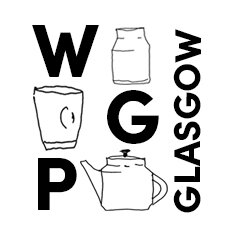Jen Smith is a Potter working from her shop and studio, Wild Gorse Pottery, in Glasgow.
Jen’s work is primarily focused on wheel thrown functional ware where comfort of use is really important. Having honed her craft over the last ten years, she has developed a distinctive style that is curious, rooted in tradition and explorative of the elemental chemistry of her materials. To that end, Jen incorporates illustration, texture and natural found materials into her work. The result is a body of work that is earthy, elemental, bold and tactile.
Texture
The texture in Jen’s work makes for beautiful, tactile surfaces. The malleability of the clay creates endless opportunities for carving, dimpling and layering the surface. In the hand, these pieces encourage interaction; running a thumb into the recess of a dimple cup, feeling the layered raw slip over the surface of a vase or the smooth edges of carved patterns on thrown and altered pieces. The texture also intentionally manipulates the glaze chemistry by creating areas of thinner and thicker application. By formulating original glazes which ‘break’ on edges Jen can play with this interaction. For example in the iron-rich Granary glaze, peaks and edges turn a toasted orange hue while smoother or concave surfaces become a rich oaty colour.
Illustration
Jen is very interested in traditional cobalt brushwork, folk art and printmaking. Using time honoured cobalt and tin glazes, Jen furthers this tradition by creating a detailed vocabulary of pattern informed by block and lino printing. The result is a familiar blue and white colour palette depicting botanical elements and simple ornamental motifs. The brushwork is applied loosely but with confidence, to maintain a liveliness and give a charming quality to the pieces.
Found Raw Materials
In recent years Jen has begun exploring the use of found natural materials such as found-clay, wood ash and sand in her work.
Growing up on the Yorkshire coast, the local cliffs were rich in red clay deposits and are now incorporated into Jen’s work as a decorative slip. Fired to stoneware temperatures, the slip blackens to a beautiful dark colour with a natural sheen where silica in the clay melts to form a textured glaze over the surface. Future experiments include milling the clay into finer particles and incorporating it into glazes. Jen hopes this will add depth of colour to the glazes in a similar way that the iron-rich Alberta/Albany slip behaves.
As an avid hiker Jen has explored many of the Scottish highlands and Islands on foot. She noticed the variety of the sand along stretches of the coastland, from the white sand beaches of Lewis and Harris, to the black volcanic beaches of Ardnamurchan. She became curious about how wedging samples of sand into the toasted stoneware she usually uses would affect the surface. The grains of sand are pulled into the glaze chemistry with everything from subtle speckles to iron rich blooms of colour. As each sample reacts uniquely, the result is a geographical marker; a surface quality linking the pot to a specific place and the elemental processes that resulted in the coarse or fine particles she has gathered.
Lastly, by gathering local wood ash to process into glaze materials, Jen has been able to create highly dynamic glazes which, though fired in an electric kiln, include features such as rivulets and an almost glittery metallic sheen that are so celebrated in wood and soda firing. Having admired these surfaces for many years, but been limited due to working in a no-fire zone withing the city, these new possibilities feel very exciting.
Jen’s approach with all of these gathered elements is not to adjust or over-process the raw materials, but instead to test them in terms of application and firing temperature to find their individual limits and beauty. They can then be used in a way that honours the natural composition of the material. Pottery is by nature a craft directly tied to the composition of the earth and this latest research is a way to more fully embrace and display that connection.













































